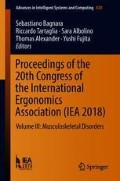Abstract
This paper presents an exploration of work related musculoskeletal symptoms and contributory factors in midwives. Data were collected with a survey (n = 635) and interviews (n = 15). The survey results showed that the majority of midwives (92%) reported musculoskeletal discomfort within the last 12 months, most commonly for the low back, neck and shoulders. The suggested main contributory factors were awkward working positions, increased work load with longer shifts and fewer breaks, and less support leading to defensive practice. The results of this research indicate that musculoskeletal symptoms are a problem among midwives with serious impacts. Strategies should be developed to manage risk factors to improve patient safety and staff well-being.
Access this chapter
Tax calculation will be finalised at checkout
Purchases are for personal use only
References
Hignett S (1996) Manual handling risks in midwifery: identification of risk factors. Br J Midwifery 4(11):590–596
Royal College of Midwives (1997) Handle with care: a midwife’s guide to preventing back injury. Royal College of Midwives, London
Steele D, Stubbs D (2002) Measuring working postures of midwives in the healthcare setting. In: McCabe P (ed) Annual conference of the ergonomics society 2002, pp 39–44. Taylor and Francis Group
Long MH, Johnston V, Bogossian FE (2013) Helping women but hurting ourselves? Neck and upper back musculoskeletal symptoms in a cohort of Australian midwives. Midwifery 29(4):359–367
De Jonge A, Teunissen DAM, Van Diem MT, Scheepers PLH, Scheepers PLH (2008) Lagrol-Janssen ALM.: Women’s positions during the second stage of labour: views of primary care midwives. J Adv Nurs 63(4):347–356
Boorman S (2009) NHS health and well being. Final Report. Department of Health, London
Royal College of Midwives (2016) Caring for you campaign: survey results RCM campaign for healthy workplaces delivering high quality care. Royal College of Midwives, London
Kuorinka I, Jonsson B, Kilbom A, Vinterberg H, Biering-Sørensen F, Andersson G et al (1987) Standardised nordic questionnaires for the analysis of musculoskeletal symptoms. Appl Ergon 18(3):233–237
Siegrist J (1996) Adverse health effects of high-effort/low-reward conditions. J Occup Health Psychol 1(1):27
Long MH, Bogossian FE, Johnston V (2013) Midwives’ experiences of work-related shoulder musculoskeletal problems. Int J Childbirth 3(1):52–64
Robson C, McCartan K (2016) Real world research, 4th edn. Wiley, London
Long MH, Bogossian FE, Johnston V (2013) Functional consequences of work-related spinal musculoskeletal symptoms in a cohort of Australian midwives. Women Birth 26(1):50–58
Palmer KT, Walker-Bone K, Griffin MJ, Syddall H, Pannett B, Coggon D et al (2001) Prevalence and occupational associations of neck pain in the British population. Scand J Work Environ Health 1:49–56
Papageorgiou AC, Croft PR, Ferry S, Jayson MIV, Silman AJ (1995) Estimating the prevalence of low back pain in the general population: evidence from the South Manchester back pain survey. Spine 20(17):1889–1894
Griffiths P, Dall’Ora C, Simon M, Ball J, Lindqvist R, Rafferty A-M et al (2014) Nurses’ shift length and overtime working in 12 European countries: the association with perceived quality of care and patient safety. Med Care 52(11):975
Rogers AE, Hwang W-T, Scott LD, Aiken LH, Dinges DF (2004) The working hours of hospital staff nurses and patient safety. Health Aff 23(4):202–212
Passmore K, Leung WC (2002) Defensive practice among psychiatrists: a questionnaire survey. Postgrad Med J 78(925):671–673
Surtees R (2010) Everybody expects the perfect baby… and perfect labour… and so you have to protect yourself: discourses of defence in midwifery practice in Aotearoa/New Zealand. Nurs Inquiry 17(1):82–92
Symon A (2000) Litigation and defensive clinical practice: quantifying the problem. Midwifery 16(1):8–14
Author information
Authors and Affiliations
Corresponding author
Editor information
Editors and Affiliations
Rights and permissions
Copyright information
© 2019 Springer Nature Switzerland AG
About this paper
Cite this paper
Okuyucu, K., Hignett, S., Gyi, D., Doshani, A. (2019). Musculoskeletal Symptoms in Midwives and Work-Related Contributory Risk Factors. In: Bagnara, S., Tartaglia, R., Albolino, S., Alexander, T., Fujita, Y. (eds) Proceedings of the 20th Congress of the International Ergonomics Association (IEA 2018). IEA 2018. Advances in Intelligent Systems and Computing, vol 820. Springer, Cham. https://doi.org/10.1007/978-3-319-96083-8_8
Download citation
DOI: https://doi.org/10.1007/978-3-319-96083-8_8
Published:
Publisher Name: Springer, Cham
Print ISBN: 978-3-319-96082-1
Online ISBN: 978-3-319-96083-8
eBook Packages: Intelligent Technologies and RoboticsIntelligent Technologies and Robotics (R0)

